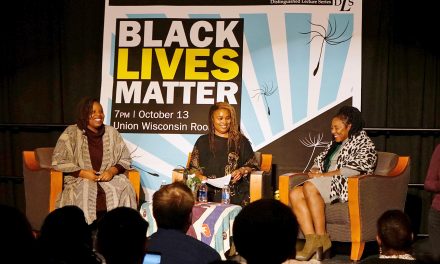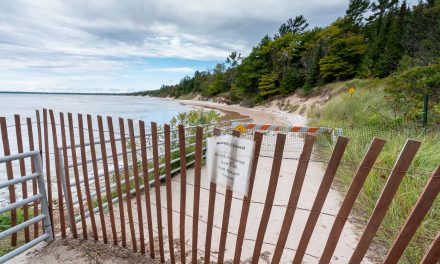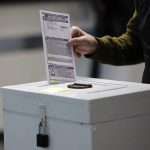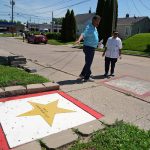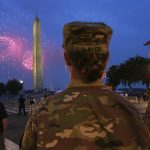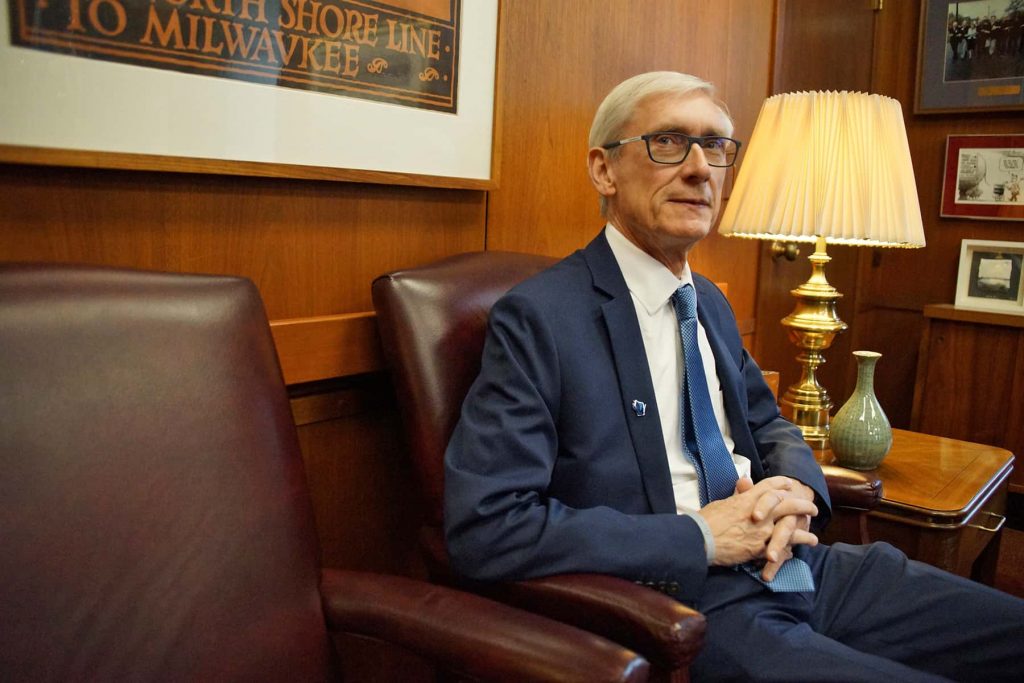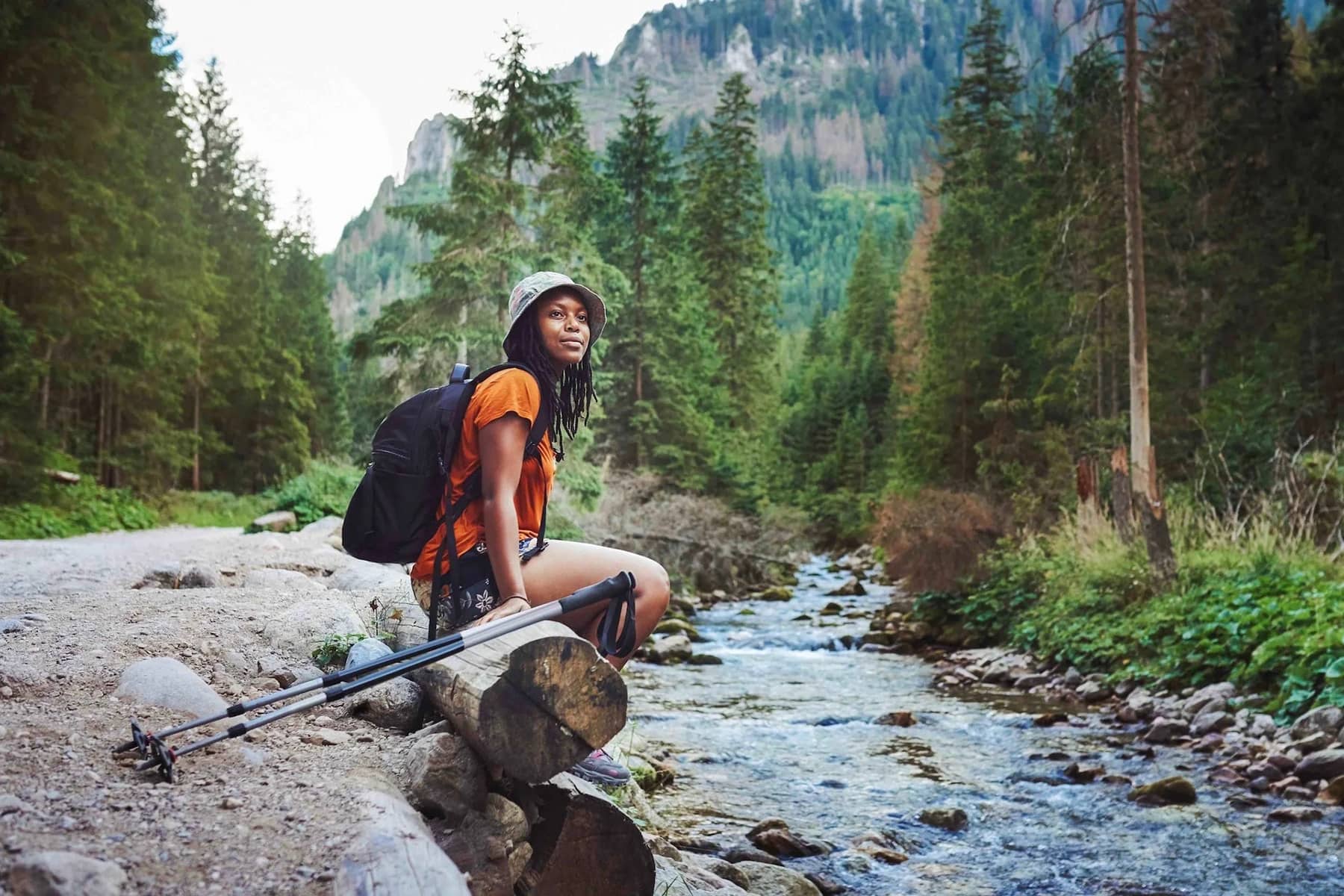
In Monroe, Georgia, on July 31, 1946, “The Savannah Tribune” reported a “mass lynching,” in which a “mob of 20 or more men, who lined up two Negro men and their wives in the woods, shot them to death.”
This horrific practice was as uniquely American in the 1940s as mass shootings are today. The consistency with which they occurred in natural spaces, especially in the South, maintains lasting effects on how African Americans engage with the outdoors. Systematic barriers, such as socioeconomic status, access to transportation, and Jim Crow laws further compounded to exclude African Americans from natural spaces.
“At some point, we got kind of pushed out of these spaces,” says National Park Service ranger Rebekah Smith, age 31, who is Black and grew up enjoying the outdoors in Georgia. She now works as a ranger at the Blue Ridge Parkway in North Carolina. Smith is driven to uncover untold stories to reinvigorate Black Americans’ love for the outdoors.
It’s part of a larger effort for current generations to reclaim their rightful place and sense of belonging in natural spaces.
“It’s time for us to go back and reconnect,” Smith says.
That’s “White People Stuff”
My maternal grandmother, Delores (known in my family as “Gima”), was born in Louisiana in 1944 and moved to Los Angeles, California, around the age of 3 as part of the Great Migration. She grew up in the Jim Crow era, and while Gima didn’t allow her relationship with the natural world to be broken, she knew where outdoor recreation was safest.
Gima was able to enjoy horseback riding, boating, and visiting Lincoln Park and beaches during summer vacation, in part because of how her elders protected her from the harshness of the social climate.
“If you went around certain places, like in Marina del Rey, not all white people, but some of ’em … you can tell how they was snobby and prejudiced,” Gima recounts. “It didn’t phase us. It didn’t phase me none.”
Still, she doesn’t venture out into “wild spaces,” claiming that Black people realize that these areas are far too dangerous, and implying a sort of naivete that white counterparts display when visiting them.
“We’re not fools,” she says. “We don’t go out there in the wilderness and lay on the ground in a tent.”
Unlike Gima, many Black people opted to protect themselves from the vulnerability of wild places by settling for life indoors or close to home. Some culturally evolved to accept the norm that outdoor recreation is “white people stuff.”
Today, though threats certainly persist, there is a thriving community of Black recreationists enjoying every aspect of the outdoors. Take, for example, the National Park System (an institution built on a foundation of dispossession and genocide of Indigenous peoples as well as Jim Crow segregation). African Americans make up only 7% of National Park visitors despite comprising 13% of the U.S. population. But many people are working to grow our presence in nature-based recreation through historical education.
In August of 2022, Smith led a program titled “Black People Don’t Do That.” In it, she explained the ways racism shaped so many of our outdoor spaces. The talk was part of an event hosted by Outdoor Afro, an organization that “celebrates and inspires Black connections and leadership in nature.”
Smith described how Doughton Park, a 6,000-acre recreation area along the Blue Ridge Parkway—the scenic road through Shenandoah National Park—was named in 1961 after Robert Lee Doughton, a U.S. House Representative, segregationist, and son of a Confederate soldier. The origins of the parkway can be partly traced to Josephus Daniels, who published racist cartoons in the Raleigh News & Observer and was one of the perpetrators of the 1898 Wilmington Massacre, a coup that burned down the offices of a local African American newspaper, banished democratic lawmakers, and murdered up to 60 people in order to pass Jim Crow laws. In later years, other white supremacists committed lynchings farther north up the Blue Ridge Parkway, in counties adjacent to Shenandoah National Park, according to the Equal Justice Initiative.
If Black people weren’t kept away from outdoor spaces by racial terror, they were shut out by socioeconomic status. According to records from the U.S. Department of Commerce, non-white men earned about 41% of the average white man’s salary in 1939, while non-white women brought in 36% of a typical white woman’s income.
Further challenging access, few Black people owned vehicles. Those who took public transportation endured a unique humiliation. They were relegated to “Jim Crow cars” and mistreatment, only to arrive at Negro-only facilities that were subpar to those reserved for whites, such as Shenandoah National Park’s Lewis Mountain.
White people and leaders chalked it up to disinterest. In a 1940 memo, then-director of the National Park Service Arno Berthold Cammerer wrote of the Lewis Mountain cabins, “I myself have felt right along that there was not sufficient demand by negroes for this particular type of accommodations to make it pay.”
Yet, despite it all, 10,217 African Americans visited Shenandoah National Park that year.
An Enduring Tradition of Outdoorsmanship
Outdoorsmanship is a longstanding tradition in the Black American community. York, an African man enslaved by Lewis and Clark alongside Sacagawea, ensured the duo’s survival with his frontier skills, especially hunting. He and others like him worked as “go-betweens” for communication and trade with the Indigenous people of North America. George Bonga, born to an enslaved person in 1802 and later free, was a renowned fur trapper who worked for the American Fur Company and helped negotiate a treaty with the Ojibwe people in 1820. Before them, maroons, a name for escaped slaves, like the African inhabitants of Virginia and North Carolina’s Dismal Swamp in the late 1700s, saw the land as a key to freedom.
In the centuries since, Black people have continued to help mold the culture of American outdoorsmanship. The land has retained its significance as a place of resistance and reclamation, continuing the maroons’ tradition.
In addition to Outdoor Afro, organizations like Hunters of Color, Diversify Outdoors, and Black Girls Hike RVA lead the charge in inviting African diasporic people into outdoors-based recreation across the United States.
Black Girls Hike RVA’s co-founders, Narshara Tucker and Nicole Boyd, said in an email that in the past, they were often the only people of color (POC) on hiking trips. This repeated experience inspired them to create “space to offer a safe and supportive environment for women of color while on the trails.” Since the organization’s founding in 2020, they’ve organized monthly hikes near Richmond, Virginia, and the Blue Ridge Mountains, leading groups of around 20 people on excursions.
“From slavery to lynchings, the outdoors have historically been a painful place for POC,” they said. “Seeing, and more importantly, welcoming black people in the outdoor recreation is vital to changing that narrative.”
When other hikers see Black Girls Hike RVA on the trail, they assume it’s a church group, “as if a group of black women cannot be intentionally on the trail and in the outdoors like everyone else,” Tucker and Boyd said. As if Black women’s love for natural spaces is abnormal or must be qualified by other, more stereotypical social structures.
On the contrary, the outdoors has long been a place of healing, where many Black people go to convene with the spiritual world.
Reclaiming Connections With the Land
“This is God’s country,” says my paternal grandmother, Marilynn (known to me as “Ma-Ma”), 68, as she explained to me the significance of her time in the outdoors. “God invented all of this … and we should be enjoying it.”
Her reverence for the outdoors is palpable as she describes what she feels when spending time in nature: “Any and everything that I had in my mind that was negative is gone. I don’t even think about it. My mind is just on what I’m seeing, enjoying the breeze, looking at the ducks, hearing the birds,” she says. “It’s very relaxing.”
Ma-Ma’s relationship with the outdoors has evolved with each generation and member of our family. As a child in Galveston, Texas, and then Los Angeles, California, she would garden, visit local parks, and even observe nature at the junkyard and airports with her dad. When she met my grandpa, she learned to fish. As a teacher, she’s now determined to share the wider world with her students.
“I want the kids to know … it’s other things out there,” she says, explaining her motivations for taking her kindergarteners on school trips. “If you’ve never been shown or introduced to nothing, how are you supposed to know it? White folks, they’re forever traveling, taking their kids here and there and showing them things. … And Black folks, it’s like we’re scared to get out and know.”
I’ve inherited Ma-Ma’s love for the natural world, including her adoration of gardening, animals, and awesome landscapes. These passions have given me and my family outdoor opportunities beyond those afforded to my grandmother in her youth. I enjoy backpacking and scuba diving. My dad and I go off-roading, something we’ve been able to introduce Ma-Ma to as well. Our relatives admire our adventurous dispositions—and have even joined us on a few excursions—but we’ve also heard our fair share of accusations, such as, “You tryna act white.”
Smith’s mom was similarly determined to instill in her a love of nature, and Smith then helped normalize wilderness-based recreation for her father. “He didn’t really go to parks or do any outdoor things until I got older and I started bringing him with me to these places,” Smith says, “to introduce him and connect with him about my work and what I’m doing.”
With such a rich history of outdoor experiences and skills, the idea that “Black people don’t go outside” is a relatively new concept—one that contradicts our lived experiences and aspirations. It is the result of extreme systemic exclusion and decades of victim-blaming. We maintain our historical love for the natural world today, though for some, it may be buried under racial stereotypes imposed upon us.
By remembering these histories—both painful and proud—and consciously welcoming loved ones into natural spaces, we can reignite a sense of belonging on this land and overcome generational exclusion in the outdoors.
Smith is hopeful that by sharing stories of Black history in the outdoors, she can help Black people overcome statements like “This stuff isn’t for us” and “We don’t do that.” Black people did and continue to do these things, Smith says. “Really, we’re just embracing our ancestry.”
This is key to the future envisioned by Tucker and Boyd: “We want black people to be outdoors and viewed as a constant and not an exception.”
Jazmin “Sunny” Murphy
Mapodile
Originally published by YES! Magazine as Black Americans Re-Embrace the Outdoors After Generations of Exclusion

